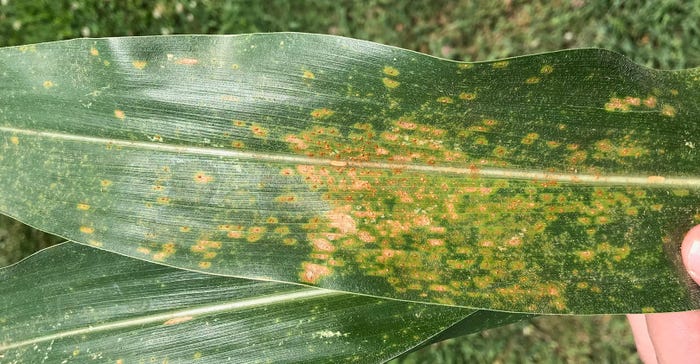July 25, 2018

The University of Missouri Plant Diagnostic Clinic confirmed that southern rust was present in a sample collected from Vernon County, Mo., in mid-July. According to the Integrated Pest Information Platform for Extension and Education, which tracks southern rust movement across the nation, it is suspected but not yet confirmed that southern rust has been observed in Pettis County, Mo.
This common corn disease usually shows up in neighboring Southern states before appearing in Missouri fields, according to Kaitlyn Bissonnette, University of Missouri Extension plant pathologist. “This year is an exception.”
Southern rust (Puccinia polysora) is a “tropical” disease that overwinters in warmer climates. Spores blow north on wind currents into corn-producing states each year.
Unusually warm and humid weather across much of Missouri creates the ideal environment for southern rust, which favors temperatures around 80 degrees F and high relative humidity. As the fungus multiplies in the host tissue, raised structures called pustules form. Masses of spores erupt through the leaf tissue.
Rust's appearance
Bissonnette says there are a few things to look for when scouting for and managing this disease. Click through the slideshow for more identification tips.
• Color. Orange to tan circular or oval pustules commonly form in dense clusters on the upper leaf surface. As the season progresses, the pustules can change to brown or black.
• Location. Rust shows first in the mid- to upper plant canopy. It appears initially along field borders or at the ends of rows, where spores can easily land on the leaf surfaces. Bissonnette says the proportion of plants affected and severity of the disease are relatively low.
• Commonality. Southern rust can be easily confused with other leaf diseases of corn, such as common rust or physoderma brown spot. Proper diagnosis helps to avoid unnecessary and costly fungicide applications, Bissonnette says.
Controlling rust
Management of southern rust depends on the crop stage and environmental conditions. For up to R3 (milk stage), applying a preventative fungicide may be beneficial. “However, it is important not to apply a fungicide prematurely,” Bissonnette says. “Infection in the early R stages can result in more substantial yield losses than in the later R stages.”
Take note of the current distribution of southern rust in the area, the growth stage of the crop and the environmental conditions, she adds, as these are the most important factors to consider when making decisions to apply fungicides. See a map of southern rust distribution at ext.ipipe.org/ipipepublic.
Because disease pressure is relatively low, exercise caution when making costly management decisions, Bissonnette says.
For more information on southern rust, its management and look-alike diseases, visit the Crop Protection Network website at cropprotectionnetwork.org.
Source: MU Extension
You May Also Like




